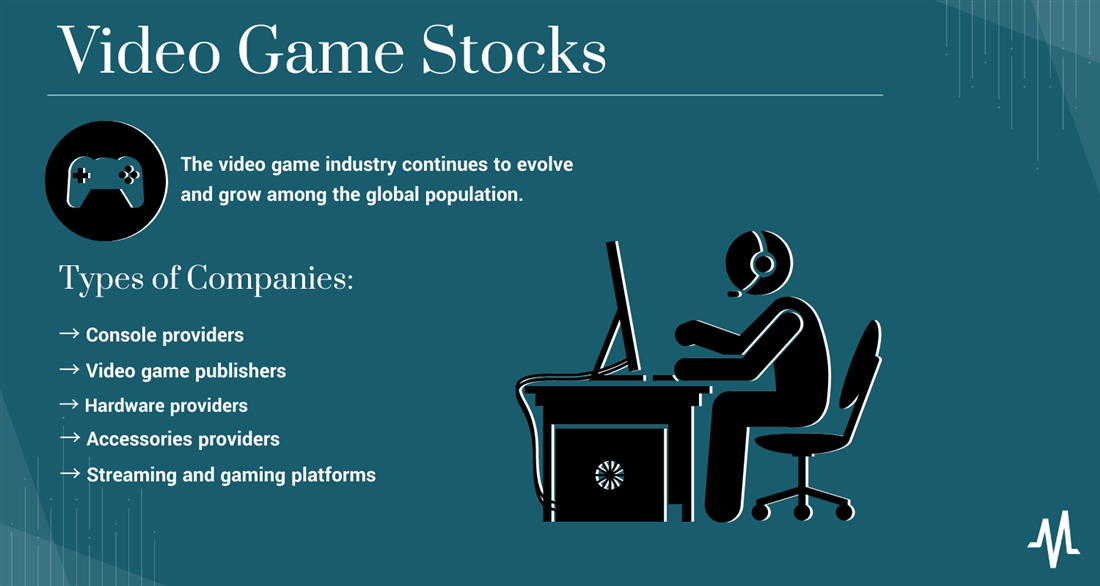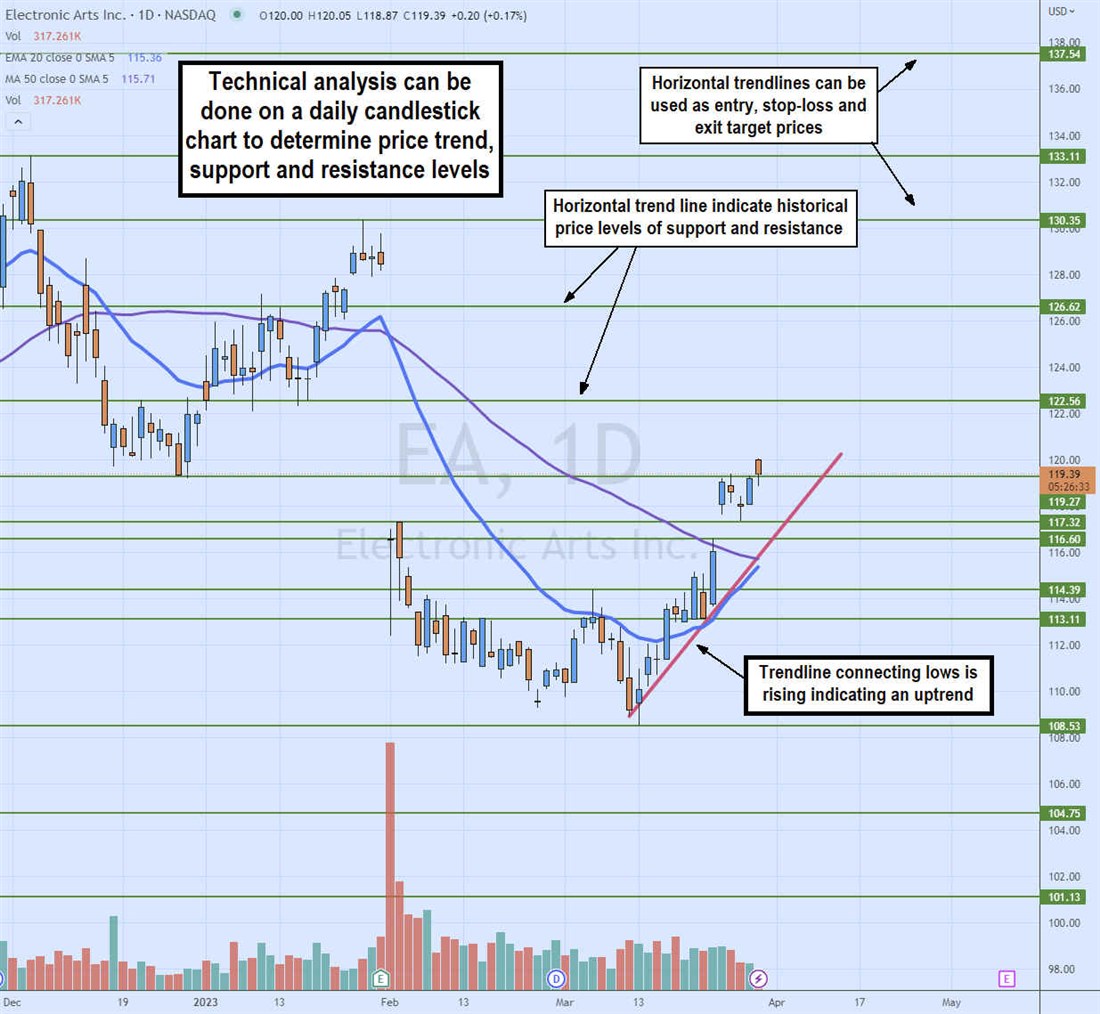The video game industry has given birth to competitive esports leagues where top professionals can earn six-digit salaries and bonuses. The industry has coined the term "gamer" as someone who enjoys playing video games and watching, competing with and against other players and embracing that lifestyle.
With that lifestyle comes many opportunities to invest in video game stocks and gaming companies. This article will explore how to invest in gaming and provide insights to get you started and help you navigate the industry.
Overview of the Video Game Industry
The video game industry represents a significant segment of the global entertainment industry. People play video games for entertainment and often provide an escape from the rigors of day-to-day life. According to Grandview Research, the video game industry has a 12.9% expected compound annual growth rate (CAGR) between 2022 to 2030. Annual revenues will likely surpass half a trillion dollars. The industry comprises many commercial components, including developers, publishers and distributors of gaming engine software, hardware providers and platforms.
Gaming has evolved from arcade machines to consoles to desktops to mobile devices. Technology continues to evolve, bringing gamers different metaverses and experiences like virtual and augmented reality.
Gaming communities continue to grow as more players enter the fray. Gross platform multiplayer online gaming helps expand playing video games with gamers worldwide. Statista expects the number of gamers to rise to 3.04 billion by 2027. It also expects 38.3% global penetration by 2027.

Why Invest in Gaming Stocks?
The video game industry is evolving, growing and penetrating the global population. Investors seek growth opportunities, which makes investing in gaming stocks an opportunistic endeavor. Video games have become embedded in culture and business. Gamification describes making non-gaming apps, processes and activities conform to video game design and mechanics to bolster end-user engagement and interest. Gamification taps into the natural desire for recognition and achievement
There are many diverse types of video game companies to invest in, depending on which area of the industry you want to focus on. Video games will continue to evolve as next-generation technologies like augmented reality (AR), virtual reality (VR) and artificial intelligence (AI) help make them more immersive and enjoyable and further broaden appeal to the masses.
Growth is the key reason to invest in video game stocks. Video game companies are finding more revenue streams beyond the initial sale of a game. These diversified revenue streams, which include microtransactions and in-game purchasing, digital distribution, membership subscriptions and advertising, help drive industry growth.
The industry is also going through significant consolidation, which can raise price multiples and valuations with each merger. The state-by-state legalization of digital sports books and Igaming drives sports betting stocks higher in that segment. This trend can help game stocks rise in the long term.
Types of Companies in the Gaming Industry
You can approach investing in the video game industry in many ways. There are pure-play video game companies and companies that benefit from the video game industry. Many companies provide a vital role in the gaming industry but also collect revenues outside of the industry. Like most consumer discretionary industries, it has peaks and valleys.
Here are some types of companies to consider for investing in the gaming industry.
Console Providers
When someone mentions video games, popular consoles like Sony PlayStation, Nintendo Switch or Microsoft Xbox come to mind. These are the most popular consoles which enable users to play video games on their TV without special equipment. The console makers usually take a loss or a small profit on each unit to build up its user base.
Console makers profit the most from game sales, microtransactions and subscription memberships. This is known as the razor and blades model, where the console is the razor, and the games are the blades. Investors have the option to invest directly in the stock of console makers.
Video Game Publishers
These primary video game makers supply, market, distribute, license, and sell titles. The video game publisher develops the games in-house or contracts out to smaller studios. Video game publishers have large distribution networks and have expanded their player networks to bolster online engagements, bringing players together and galvanizing loyalty. Publishers are often known for having popular gaming franchises, which get updated and expanded regularly. Publishers have also expanded into mobile gaming offerings. Investors can invest directly in various video game publishers.
Hardware Providers
Desktop gaming continues to gain mainstream popularity. These are high-performance PCs, also known as 'rigs,' which can cost several thousands of dollars to build and optimize. Initially, PC gamers were a subculture of computer enthusiasts familiar and comfortable with constructing their gaming rigs. They require faster central processing units (CPUs) and graphic processor units (GPUs).
PC makers helped mainstream gaming by building high-performance, preconstructed gaming rigs that newbies can use immediately. Investors can invest in hardware providers, including PC makers, CPU and GPU chipmakers and various component manufacturers inside a gaming rig.
Accessories Providers
Gamers need accessories to play video games. These include controllers, joysticks, headphones, headsets, mouses, gaming chairs, keypads, cameras, premium accessories like cockpits, professional steering wheels and gears.
Investors can invest directly or indirectly in accessory makers by buying stock in hardware makers that manufacture accessories.
These are various providers that enable viewing and participating in video game activity. They can be subscription-based, free-to-play or in-game purchasing services, including metaverses, platforms and subscription services.
Investors can invest directly in the companies that provide these services, like e-sport leagues, gaming engines or publishers that also provide streaming services. E-sports leagues also create gaming communities that continue to grow.
How to Invest in Gaming
If you've decided to invest in the video game industry, it's time to review the steps to help make your investment pay off. Here are the five steps to consider taking before you invest.
Step 1: Research the industry.
It's a good idea to get a general idea of the trends in the video game industry. Reading articles on the video game industry in general and specific segments is a good idea. You can do a keyword search for “video game makers” on MarketBeat.com to pull up news and articles to help familiarize yourself with the industry. It will also pull up some video game stocks you can research.

Step 2: Find companies to consider for investment.
Compile a list of stocks that fit your criteria. Compile a list of video game stocks to consider for investment. You can also do a keyword search based on specific segments like “video game hardware makers.”
MarketBeat Originals articles will also supply stock candidates to consider. You can also use MarketBeat’s stock screener to help compile your list. If you're interested in the e-sports segment, here are the best e-sports stocks on MarketBeat.
Step 3: Do fundamental analysis research.
This involves researching the underlying business operations for each of your stock candidates. Read through the latest earnings reports, press releases, articles and analyst research reports and articles. Note whether the company is growing sales and profits or if its losses are growing. Be aware of upcoming material catalysts that can move the stock, like earnings reports, scheduled presentations and live events and new video game releases.
Compare the various financial metrics ratios between the stocks on your list, including price-earnings (P/E), price-book (P/B), price-sales (P/S) and cash-per-share (CPS). You can tell if you've done your research if you can "pitch" the stock to someone in a few sentences.
For example, you might say, ”XYZ is a video game publisher with 30% year-over-year (YoY) revenue growth in its latest quarter trading at a relatively low P/E of 15. The company raised its next quarter and full-year EPS and revenue guidance. Its widely expected sequel title to its top seller will be released next month and will become a Netflix series."

Step 4: Complete technical analysis research.
Technical analysis involves researching the price history for potential chart patterns. Use a daily candlestick chart and determine the trend and support and resistance levels with horizontal trendlines.
Draw a trendline connecting the lows to gauge if the price trend is up or down. You can add indicators like a 20-period exponential moving average (EMA) and a 50-period moving average to act as additional support or resistance levels.
If the stock price is below a line, then it’s resistance, and if it's above a line, then it’s support. You can also use these lines to determine your entry, stop-loss and target levels. In a nutshell, you should be able to point out the direction of the trend near support and resistance levels for any of your stocks.
Step 5: Manage the trade.
Managing the trade involves preparing the entry, stop-loss and exit prices, executing the trade and monitoring the stock(s). Once you've finalized the stock(s) you want to invest in, it's time to assemble the plan.
Premeditate your entry price level(s), stop-loss and possible upside target price level(s). Ensure you aren't chasing the stock price too high. Use an online broker to place and execute your trade. Once you have gotten into position, make sure to watch it occasionally.
It's a good idea to set alarms with your broker or an app to alert you when the stock is rigid upon a stop-loss or upside target price so that you can take the necessary actions. If all this sounds complicated or tedious, you can leave it to the professionals who invest in a video game-related exchange-traded fund (ETF). Use the MarketBeat ETF screener to find them.
Pros and Cons of Investing in Video Game Stocks
As with any investment, there are pros and cons. Here are some common ones to consider before buying any stocks.
Pros
What are the benefits of investing in video game stocks? Let’s take a look.
- Upside profit potential: Video game stock prices can rise as the company and industry grow revenues and earnings.
- Technological innovations: In pursuing entertainment, next-generation technology will continue to spawn and develop. These advancements often start in the video game market and spread to other sectors like the enterprise business market.
- Diversification: Having a portion of your portfolio in video game stocks can help diversify the overall portfolio. It helps to have investments across different sectors and industries to offset weaknesses in one with strengths in another.
Cons
The downsides of investing in video game stocks include the following:
- The downside risk of loss: Stocks rise and stocks fall. The risk of losing money in video game stocks is one of the major cons of any investment. Therefore, it's essential to have and keep stop-losses on the stock.
- Big release flops: Video game companies are very much like movie companies. It can take years to finish the product as hype, anticipation and expectations are high going into the release. If the release flops, it can significantly impact the stock. Owning video game stocks exposes you to the risk that a big title may not sell well.
- Falling behind the curve: Since video games need to be on the edge of innovation, not all video game companies will be riding that wave. Some will need more talent or funding, and their stock follows.
Future of Video Game Stocks
The future of the video game industry is bright. More technological innovations are expected on all fronts of the supply side. Graphics should continue to improve, eventually becoming photo-realistic. The demand side should continue to grow with vigor due to the new generations of digital natives, babies born in the digital and the mobile era. While people of all ages play video games, the presence of digital natives like Gen-Z and Gen-Alpha has embraced the mobility aspect.
This has caused the mobile gaming market to outpace desktop and console video gaming segments. The future will continue getting more gamers connected with more streaming, gaming share and multiplayer engagements through the cloud. Access, convenience, speed and immersion aspects should continue to improve in the future for video games, and stocks should follow.
Continue Your Gaming Research
The investment doesn't end after buying the game stock. Companies and stock prices are dynamic, and material events like earnings reports can completely shift investor sentiment, which drives prices.
Read new earnings reports as they come out every three months. Note if the earnings beat analyst estimates and if they guided higher or lower with its following earnings report. If fundamentals break down, then consider trimming or exiting your position completely. If you still feel confident about the company, proceed with holding the stock(s). Adjust stop-loss and upside price targets accordingly.
FAQs
Here are some answers to frequently asked questions regarding whether or not to invest in gaming company stocks.
What is considered a gaming stock?
Video game stocks are companies that are involved in the video game industry. They may direct providers of consoles, hardware, accessories, video game titles, software and services.
Are gaming stocks a good stock investment?
Gaming stocks can be a good investment. The video game market is expected to continue growing to over half a trillion dollars by 2030. They will penetrate nearly half the global population by then.
Are gaming stocks risky?
As with any investment in stocks, they can be risky. Therefore, prepare using fundamental and technical analysis to premeditate entry price(s) and exit price(s). Try not to impulsively buy stock without doing the research first.
